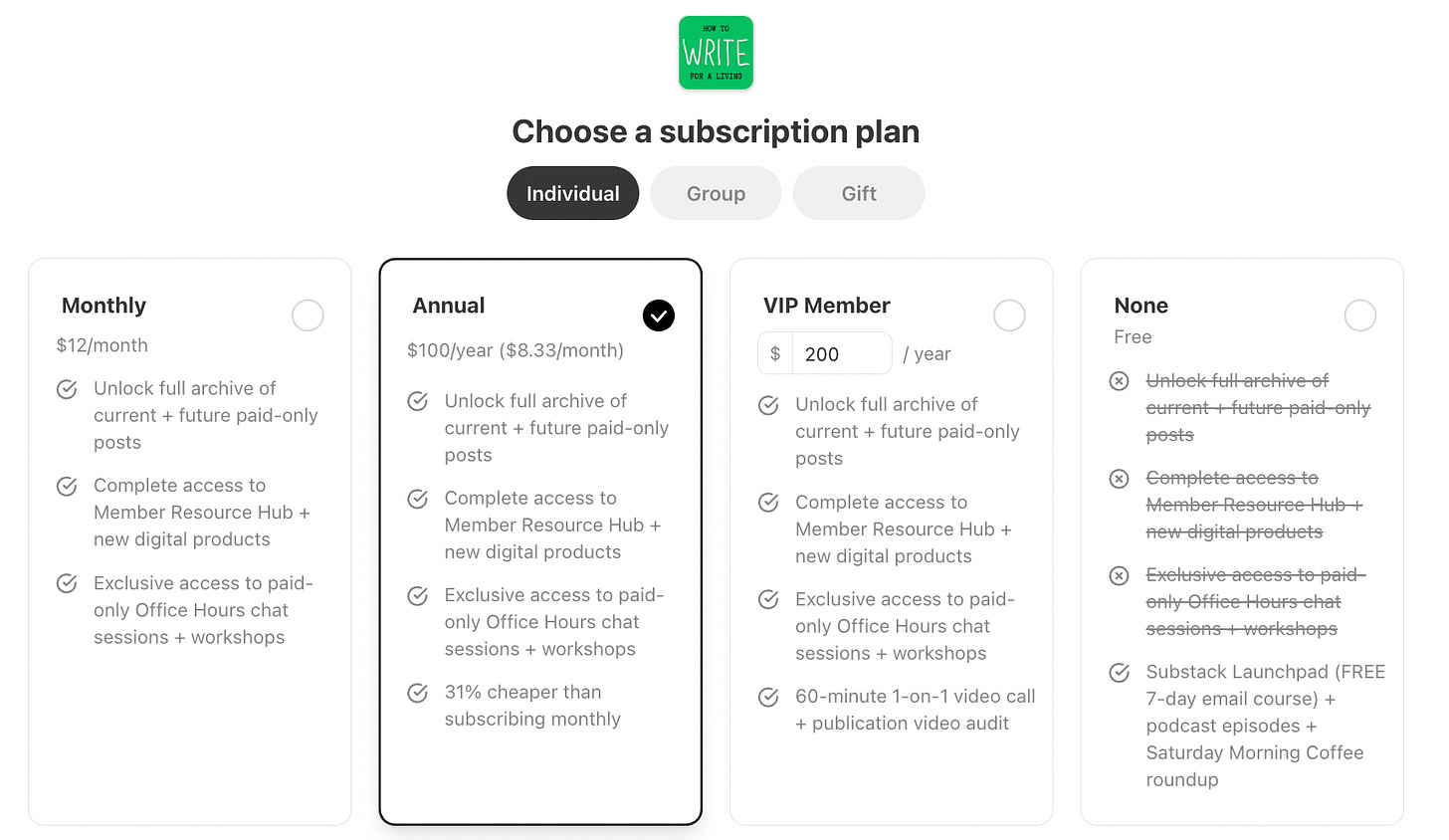Newsletter Circle is your go-to source for building a successful newsletter business through a paid subscription.
When you’re running a paid newsletter, one question always comes up:
What’s the most relevant offer I can create for my paying members?
It sounds simple until you try to answer it. And the beauty of this question is that it forces you to dig deeper into your entire newsletter strategy.
Because before you can answer it, you first need to wrestle with questions like:
How do I really know what my audience wants?
What’s the best way to gather and act on feedback?
How do I test different perks without overwhelming myself?
If I add community benefits, how do I actually manage them?
Where’s the right balance between free and paid content?
This week, I sat down with
to unpack how he’s approached all of these challenges.David isn’t just another newsletter writer; he’s writing for writers to help them get paid for what they love to do. He’s a Substack Bestseller with 25,000+ subscribers and 200+ paying members. He’s built a reputation for smart collaborations, strong engagement on Substack Notes, and creative perks like live Zoom sessions and workshops on top of his paid content.
From our conversation, I pulled out some golden takeaways you can apply to your own newsletter as you shape (or rethink) your paid offer.
Grab your notes; these insights are worth stealing.
1. Consider your personal branding from day one
When I asked David whether content alone was enough, his answer was clear: no. Content gets people in the door, but personal brand is what convinces them to stay and pay.
He admitted that, as an introvert, showing up on camera and presenting himself online wasn’t natural. But he pushed himself anyway, because readers want to see the human behind the words. His upcoming coaching program (Writer Brand Lab) is built entirely around this idea: helping writers create personal brands that feel authentic and trustworthy.
Why it matters: Readers subscribe to people, not just posts. If your subscribers trust you, they’ll follow you across formats, support you financially, and even join community offers.
How to Apply
Define how you want to show up from the start (voice, tone, style, platforms).
Don’t force a fake persona. Lean into traits that make you authentic.
Add more presence: show your face or voice through Notes, video, or podcasts.
Treat brand + content as a package. Strong branding won’t save weak content.
2. Ask your audience directly what they want
David admitted that in the early days, he had no idea what to offer. He simply did what others were doing on Substack — paywalling some posts, keeping others free — and hoped it worked.
Over time, he realized the guesswork wasn’t enough.
The turning point was when he started asking his readers outright: “What do you want from me?”
He used polls, surveys, and direct questions, then noticed patterns in the answers. Some feedback was unrealistic, some too simple, but certain themes kept repeating; those became his signals.
Why it matters: You can’t design the right paid tier in isolation. The only way to know what resonates is to involve your audience and listen for patterns.
How to Apply
Add simple polls in weekly roundups.
Use Substack’s survey function in posts and welcome emails.
Ask direct, bold questions in Notes or Substack Chat.
Collect feedback in one place (spreadsheet or doc) to track patterns.
Lean into strengths — offer what you’re best at, not what others do.
3. Build community, not just content
David realized that what subscribers value most isn’t just more material, it’s proximity. They want direct access to the creator and a space to connect with others who care about the same things.
He experimented with webinars and office hours.
At first, he kept them free to test the format, later making replays exclusive to paid members. His format was part teaching, part conversation: a short presentation, then open Q&A. As he put it,
“It’s not a one-to-one. It’s one-to-many — more like standing on a stage where the whole community can hear and bounce ideas off each other.”
Why it matters: A community perk is sticky. Content can be consumed anywhere, but people won’t want to walk away from belonging to a group. Remember: community builds retention. People don’t cancel when it means losing a tribe.
How to Apply
Run free webinars first, then make replays exclusive for paid members.
Collect questions in advance to spark richer discussions.
Use a mix of formats: presentation + open Q&A.
Encourage interaction between members, not just with you.
Frame community perks as “special access” that free readers can’t get.
4. Treat experimentation as a process, not a phase
“In the early days, I didn’t really know what I should offer… I was just guessing,” David told me.
Over time, he discovered that trial and error wasn’t just unavoidable, it was the point. Each failed attempt gave him signals about what worked and what burned him out. Now, his approach is to test widely at the start, then double down only on what feels sustainable long-term.
“ There's always an element of experimentation and guessing on Substack and being a creator in general.
And I think anyone who's doing this has to know that it's going to probably take a little bit of time before you arrive at that point where you know exactly what your paid tier should look like and what it should include.”
Why it matters: Every creator starts in the dark. Iteration isn’t a mistake; it’s the path to clarity. What matters most is sustainability: perks you can keep running for 12+ months without burnout.
How to Apply
Expect guesswork in the beginning; it’s normal.
Run small experiments before committing.
Watch engagement before scaling an idea.
Avoid overpromising — focus on 2–3 sustainable perks.
Reassess regularly and be willing to evolve.
5. Balance free and paid with a clear strategy
For a long time, David wasn’t sure where the line should be between free and paid. At first, he simply paywalled random posts and hoped the balance would sort itself out. But over time, he realized that the approach was confusing both for him and for his readers.
Now, he’s reshaping his publishing cadence to make free and paid posts work together rather than compete with each other. Instead of treating them as separate tracks, he’s making them two halves of the same story.
His exact strategy:
4 posts a week: Podcast (Sunday), free post (Tuesday), paid post (Thursday), roundup (Saturday).
The Tuesday free post introduces a topic and gives partial solutions.
The Thursday paid post continues the conversation — offering the complete, in-depth solution.
The free post funnels readers naturally into the paid one by ending with a clear call to action.
Why it matters: This system ensures that free readers always get value while also seeing exactly what they’re missing by not upgrading. Paid readers, on the other hand, feel like they’re getting the whole picture — not just “bonus content” tacked on top.
How to Apply
Pair your free and paid posts around the same theme so they reinforce each other.
Use the free post to open a loop (start the story) and the paid post to close it.
Position free content as genuinely valuable — not watered down — so it attracts new readers.
Make the CTA at the end of your free post specific: “Part 2 continues here” or “Full breakdown available in the paid edition.”
Treat your publishing cadence as a funnel; free builds trust, paid deepens value.
6. Keep it simple if you’re starting over
When asked what he’d do differently, David said:
“I would turn my pay tier on right from the start, even before I felt like there was enough there to go on. Some people will want to support you based on your free stuff alone.
I’d also keep it simple, maybe three strong benefits instead of seven or eight. Go for quality over quantity.”
Why it matters: You don’t need a perfect setup to launch. A small, clear offer beats an overwhelming list of perks you can’t sustain.
7. Think of paid content as a separate product
Paid should feel like its own product, with its own promise, value, and identity, not just a continuation of free content.
David’s biggest advice: don’t just put a paywall on your free content.
“Think of your paid tier and your paid content as a separate product from your free stuff. It’s not that you have free content and you’re just slicing it in half with a paywall.
If you can differentiate between the two, the entire process feels so much more straightforward.”
8. Accept that it’s an ongoing journey
Finally, David reminded us that even successful creators don’t have it all figured out:
“Don’t feel like you’re going to figure it out immediately. There will be ups and downs. You’ll lose paid subscribers along the way and gain some unexpectedly.
It’s an organic, ongoing process, just be part of it for the long term.”
Paid growth isn’t linear.
The long-term game is retention, iteration, and consistency, not expecting perfection from day one.
✨ Keep going, keep experimenting, and remember, progress compounds over time.
Before You Go
🎥 Watch the full live interview to hear more about building relevant paid offers.
🔎Check my previous written interview with David to learn more about his full journey and his proven newsletter growth strategies.
🔎 Explore 5 popular myths about building a paid newsletter and why you should stop believing in them.
Thanks for reading, and feel free to reply if you’d like to connect!
See you next week.
Ciler
Find me on Substack Notes & LinkedIn















Share this post